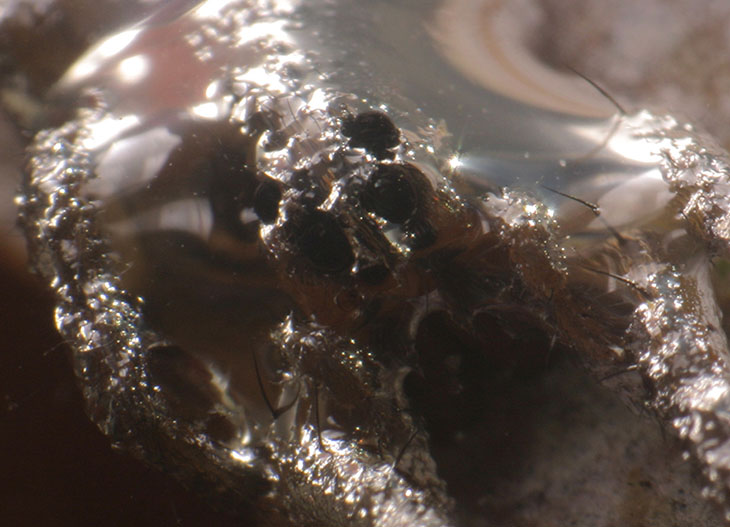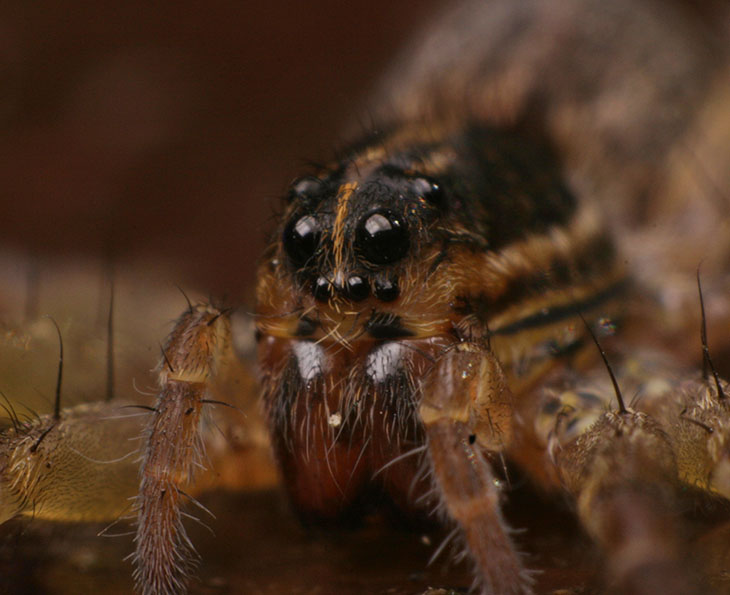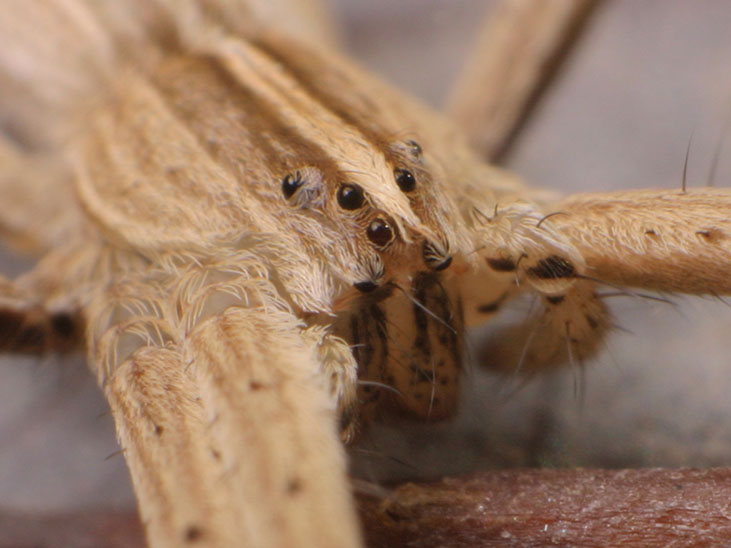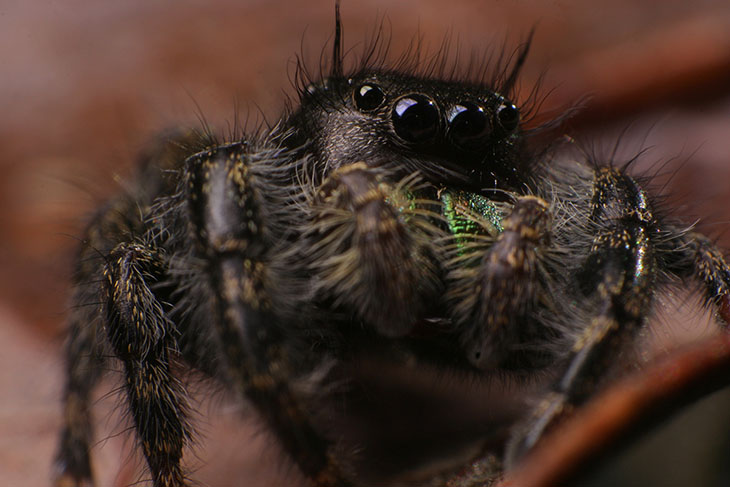After yesterday’s monsoon (which was hard enough for us to be watching for the signs of tornados,) there remains a fair amount of standing water in various places, and the yard is nothing more than a sponge right now. In a shallow pan this morning, I spotted a couple of spiders hanging out, one obviously a species of fishing spider. I pointed the largest out to The Girlfriend.
“Can he get out?” she asked.
“He should have thought of that before he got in, shouldn’t he?” was my reply. I’m very Darwinian.
Nonetheless, I put a leaf in the pan, propped up on the side, while I went in to fetch the camera (no, this doesn’t mean I carry it in my mouth. Don’t ask me why we use these terms.) When I came back out, I thought I spotted motion on the leaf but there was nothing to see, including any sign of the fishing spider. My suspicions were confirmed when I turned the leaf over and found the spider clinging to the underside, submerged well under the surface.

I’ve written about these before, but you likely forgot all that info, so I’m posting this refresher – remember to thank me when it comes in handy later on in saving a busload of children. Some species of fishing spider are equally at home under the water’s surface as they are on land, since air clings to their bodies courtesy of both water tension and the little hairs they have that makes them so adorable. Most arthropods breathe through openings on their abdomens called spiracles, so the bodysuit of air is ideally located.
My subject here kindly stayed put as I transferred the leaf into the macro tank, and of course I’m accommodating enough to my readers to go in for the extreme portrait shots, allowing you to get lost in those eyes. The effect with the light angle and the magnification was especially potent – I’m betting these pics provoke a strong emotional response.

This specimen, at full leg spread, would not quite cover the pad of my index finger, and this image lets you to see how the surface tension of the water allows for a fair amount of air to be trapped, spanning across small gaps, while the larger hairs poke right through the surface. Remember that this is inverted from expectation – you’re looking through the water, and the silvery membrane is the air pocket. But I noticed something that I never had before: the air specifically does not cover the eyes at all, instead going right to their very edges and stopping. This makes sense biologically, because it prevents the distortion that the air/water interface would produce and thus the spider can see better, but how it occurs was the question.
I wondered if the spider actually cleared its eyes with a foreleg or pedipalp upon submersion, so I did a few experiments with drawing the leaf in and out of the water as the spider clung to it. Nope – the effect is immediate. Then I pondered if the hairs right alongside the eyes grew finer or disappeared altogether, preventing the water from standing off away from the body, and so I went for the same closeup while the spider was out of the water.

Uhhherrrmmm, maybe – obviously the hairs don’t stop, but they might be a bit shorter, and they do seem to lay flatter around the eyes. Still, the demarcation is so distinct that I’m inclined to believe the surface of the eyes is especially friendly to water, actually reducing the surface tension like the ‘sheeting’ treatments you can put on windshields, or the wetting agents used in film developing (I know, I’m talking gibberish now.) While getting this image, the spider lent a small amount of evidential support for this idea by quickly wiping its eyes with its dainty feminine pedipalps, exactly the behavior I was looking for when it submerged, not when it surfaced. That’ll show me.
I thought I had some images showing dewdrops actually sitting on the surface of a fishing spider’s eye, which would put the lie to the surface tension theory, but going back and looking at the one I remembered, the dew was on the cephalothorax near the eye, not on it. One of these days I’m going to have to capture a larger specimen and experiment with the misting bottle to see if this idea holds water (a ha ha) – or I could just ask someone educated. But that’s not as much fun.
While I have read that fishing spiders actually hunt aquatic critters underwater, I have never seen evidence of this myself, and it might not apply to this species. The only thing I’ve seen has been hunting while skating across the surface, but I’ve also never convinced a spider to stay in the tank while it was occupied with likely subsurface meals either, so this lack isn’t indicative of much. But since you were about to ask, here’s one from last year showing off the jesus thing while munching on a spittlebug.

Playing around with the light angles eventually produced good definition around the feet, showing how they bend the water surface down without breaking through, yet when the spider wants to go under, it can do so effortlessly – I’m guessing it depends on the angle of the foot. Or it could be telekinetic I guess. I’m constantly reminded by UFO proponents and the religious to keep an open mind, so let’s not rule out hyperdimensionality either…
While I was out today, I did a couple more tight portraits of arachnids. This one was found on the pampas grass the other day as I was cutting it back for the winter, and is perhaps 50% larger than the fishing spider from today.

After some searching, I’m fairly certain this is a slender crab spider (Tibellus maritimus,) – I never would have placed it as a crab spider myself because, you know, I figured they would look like a crab and not a twig, but what do I know? It illustrates the difference between common and scientific names, however, because the species I typically associate with “crab spider” are from the family Thomisidae, while this one is of the family Philodromidae – they’re only distantly related. The eyes can reveal all.
And to make up for my pathetically low numbers of spider images in the past year, I add in another taken today, a bold jumping spider (Phidippus audax,) who is certainly more scared of you than you are of it, as demonstrated by the hair and the wide-open eyes. Poor little guy…





















































